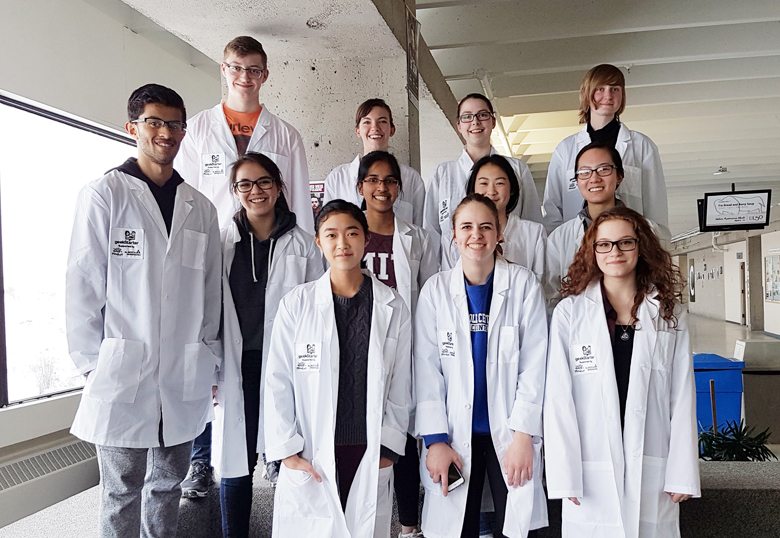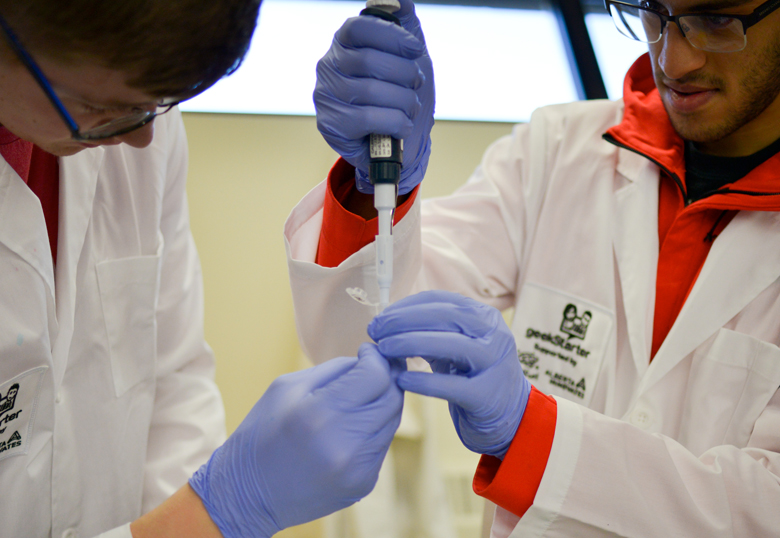Given the cost of printer ink and the environmental consequences of its manufacture, this year the University of Lethbridge high school iGEM team has chosen a project that might solve both problems.
“Our project is the development of biological pigment for use in the manufacturing of ink,” says Erin Kelly (BSc ’17), a U of L master’s student and graduate student coordinator of the High School iGEM team. “We found that the manufacturing of the pigment in the ink can actually be a harmful process to the environment, as well as being quite costly.”
The project will use synthetic biology to create pigment substitutes — like the black, cyan, magenta and yellow found in printer ink — that can be found in nature. Synthetic biology is the design and construction of new biological entities, which can be enzymes, genetic circuits or cells, by redesigning existing biological systems. Currently, the pigment in black ink is obtained by burning petroleum while other pigments are chemically synthesized or come from minerals that are mined.

“Other pigments we’re using are found in different types of flowers,” says Sydnee Calhoun, a biochemistry student, team advisor and member of the Collegiate iGEM team. “For example, the magenta pigment we’re using is found in apple trees.”
“You can also extract pigments from plants, but that’s not necessarily a sustainable practice in all cases,” says Kelly. “The advantage of synthetic biology is we control our own system so we’re using bacteria, which are easily reproduced and more sustainable than plant extraction, for example, to make these pigments. They’re very easy to grow and easy to control, as are their genes. We’re doing a bit of genetic engineering to transfer the genes from plants that make these colours to the bacteria, so we can make more pigment in a smaller volume of space.”
Since January, the team, comprised of a dozen high school students from Lethbridge Collegiate Institute, Chinook High School and Winston Churchill High School, has been designing the project and working on the human practices component with the guidance of student advisors and faculty members, Drs. Brian Dempsey and HJ Wieden, through the U of L’s Department of Chemistry and Biochemistry and the Alberta RNA Research and Training Institute (ARRTI). The human practices portion helps team members imagine their project in the real world and identify any potential problems in the design stage.
“For this project, we were initially seeing how this could work as an alternative business venture, compared to normal ink manufacturing processes,” says Calhoun. “They’re also conducting more research into the current environmental practices in ink production and comparing that with a synthetic biology approach.”

“The students were thrilled to receive these awards,” says Kelly. “They’ve approached their project with a lot of energy and enthusiasm, so winning these awards has confirmed that their efforts have been worthwhile.”
Allison Leam, a Grade 12 student from Lethbridge Collegiate Institute, says she’s gained lab skills, learned to work as part of a team and how to commit to a project.
“If a student likes science and can commit the time, then I’d advise them to join iGEM. They’ll learn a lot and it’s a lot of fun,” says Leam. “They’ll get experiences they won’t get anywhere else and meet a great team of people who all want to be there.”
The next step for the team is to see if their project will work as they plan. They’ll be testing the DNA sequences of the pigment sources and determining whether engineered E. coli bacteria can produce the various pigments. If they do, the students will extract the pigment and use it to make an ink, something they hope to demonstrate to judges when they take their project to the iGEM Jamboree in Boston, Massachusetts in November. At a high school competition in June, the team received positive feedback about its project from judges and peers. The team was awarded Best Communication at the competition.
Tentatively, the team will present their project at a city council meeting on Aug. 28, followed by a public display in the foyer of City Hall from 5 to 7 p.m. Please check the U of L iGEM Team Facebook page for future updates.
The team also has a GoFundMe account to help fundraise to send team members to Boston. All contributions are appreciated.
